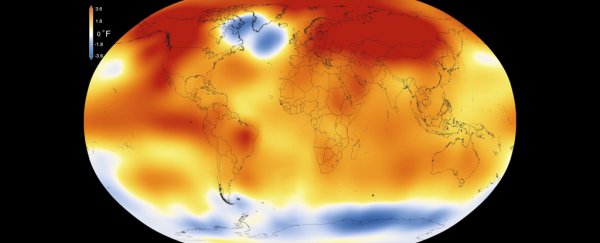Surface temperatures on Earth set a new record last year, with the global average temperature in 2015 being the hottest since modern record-keeping began in 1880.
Separate analyses by NASA and the National Oceanic and Atmospheric Administration (NOAA) reveal that the global average temperature broke the previous record – set in 2014 – with a rise of 0.13 degrees Celsius (0.23 degrees Fahrenheit).
This rise, in itself the second largest increase in the global average temperature ever, continues a long-term warming trend that has seen 15 of the 16 warmest years on record occurring since 2001.
" Climate change is the challenge of our generation, and NASA's vital work on this important issue affects every person on Earth," said NASA Administrator Charles Bolden. "Today's announcement not only underscores how critical NASA's Earth observation program is, it is a key data point that should make policy makers stand up and take notice – now is the time to act on climate."
NASA's data is sourced from 6,300 weather stations located all over the world, in addition to a number of ship- and buoy-based systems measuring sea temperatures, and research centres stationed in the Antarctic.
The calculations resulting from all these observation points provide an estimate of the global average temperature difference from a baseline period of 1951 to 1980.
To see a demonstration of the long-term warming trend since 1880, NASA made the following animation, which shows the world slowly getting ever hotter over the past 135 years:
In the animation, orange colours represent temperatures that are warmer than the 1951–1980 baseline average, while blues indicate temperatures that are cooler.
The back-to-back record temperatures set in 2014 and 2015 provide further evidence (in case it's needed) that the world is in a state of global warming. According to at least one estimate, the odds of setting such records in two successive years would be about one chance in every 1,500 pairs of years if the climate were not warming – although this increases to a more likely one in 10 chance in a situation where the planet is warming.
Weather phenomena such as the current El Niño are one of the reasons 2015's temperature was so high – and why it may increase again next year – although it doesn't tell the whole story of why we're seeing such record-setting temperatures.
"2015 was remarkable even in the context of the ongoing El Niño," said Gavin Schmidt, director of NASA's Goddard Institute for Space Studies. "Last year's temperatures had an assist from El Niño, but it is the cumulative effect of the long-term trend that has resulted in the record warming that we are seeing."
But what about next year? "It's not unprecedented to have two years in a row of record-breaking temperatures, but in our records, we've never had three years in a row," Schmidt told Deborah Netburn at the Los Angeles Times. "If 2016 turns out to be as warm as we anticipate, that would be unprecedented in our record book."
